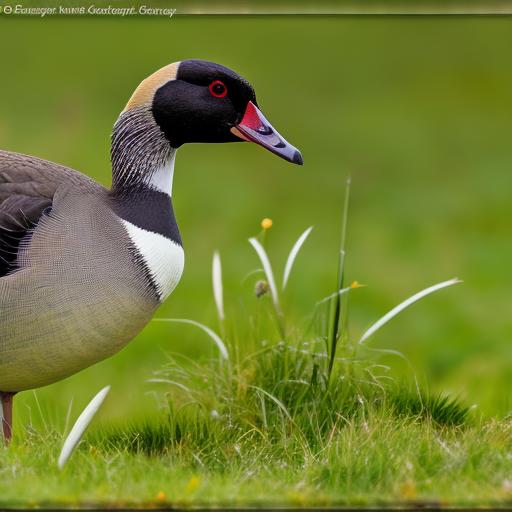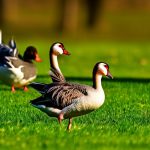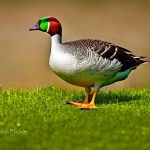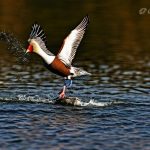Canada geese are a common sight in many areas of North America, including lawns and parks. These large birds are known for their distinctive honking sound and V-shaped flight formations. While they may be beautiful to observe from a distance, having Canada geese on your lawn can be a nuisance. They can cause damage to your lawn and pose health risks due to their droppings. In this article, we will explore the behavior of Canada geese, the importance of deterring them from your lawn, and various methods you can use to keep them away.
Key Takeaways
- Canada geese are social birds that mate for life and are highly adaptable to urban environments.
- Canada geese can cause damage to lawns, create safety hazards, and spread disease through their droppings.
- Physical barriers such as fences, hedges, and water features can deter Canada geese from landing on your lawn.
- Bird netting can be installed over your lawn to prevent Canada geese from feeding on grass and plants.
- Decoys, sound deterrents, and taste deterrents can be effective in scaring off Canada geese, but may require regular maintenance.
Understanding the behavior of Canada geese
Canada geese are migratory birds that typically breed in northern regions and migrate south during the winter months. They are social animals that travel in large flocks and often return to the same nesting sites year after year. These birds are attracted to areas with open grassy spaces, such as lawns, golf courses, and parks, where they can find food and water.
Canada geese are herbivores and primarily feed on grasses, grains, and aquatic plants. They have a voracious appetite and can quickly strip a lawn of its vegetation. In addition to feeding, Canada geese also spend a significant amount of time resting and grooming on lawns. Their constant presence can lead to trampled grass, unsightly droppings, and damage to landscaping.
The importance of deterring Canada geese from your lawn
Having Canada geese on your lawn can cause several problems. Firstly, their feeding habits can result in significant damage to your lawn. They will graze on grasses, pulling them up by the roots and leaving bare patches behind. This can lead to an unsightly lawn that requires costly repairs or reseeding.
Furthermore, Canada goose droppings can pose health risks. Their droppings contain bacteria that can contaminate water sources and cause diseases such as E. coli and salmonella. If you have children or pets that play on your lawn, the risk of exposure to these bacteria increases. It is essential to deter Canada geese from your lawn to protect both your property and the health of your family.
Using physical barriers to keep Canada geese away
One effective method of deterring Canada geese from your lawn is by using physical barriers. Fences or hedges can be installed around the perimeter of your property to prevent geese from accessing your lawn. These barriers should be at least three feet high and extend underground to prevent the geese from digging underneath.
The key to using physical barriers successfully is to ensure they are properly installed and maintained. Regularly inspect the fence or hedge for any gaps or damage that may allow geese to enter. Additionally, consider using materials that are difficult for geese to perch on, such as smooth surfaces or angled tops on fences.
Installing bird netting to protect your lawn
Another effective method of deterring Canada geese from your lawn is by installing bird netting. Bird netting is a lightweight mesh material that can be draped over your lawn to create a physical barrier between the geese and the grass. It is important to properly install the netting so that it covers the entire lawn and is secured tightly to prevent geese from getting underneath.
When installing bird netting, make sure it is at least six feet high to prevent the geese from flying over it. Additionally, regularly inspect the netting for any tears or damage that may allow geese to access your lawn. Bird netting can be an effective long-term solution for deterring Canada geese, but it does require regular maintenance and monitoring.
Using decoys to scare off Canada geese

Using decoys is another method that can be effective in deterring Canada geese from your lawn. Decoys are objects that resemble predators or other animals that geese perceive as a threat. By placing these decoys on your lawn, you can create the illusion of danger and scare off the geese.
Common decoys used to deter Canada geese include fake owls, coyotes, or even alligators. It is important to move the decoys regularly to prevent the geese from becoming accustomed to their presence. Additionally, consider using decoys that have moving parts or make noise to further enhance their effectiveness.
Using sound deterrents to keep Canada geese away
Sound deterrents can also be effective in deterring Canada geese from your lawn. These devices emit loud noises or alarms that startle the geese and make them uncomfortable. There are various types of sound deterrents available, including motion-activated devices, ultrasonic devices, and even recordings of predator calls.
When using sound deterrents, it is important to place them strategically around your lawn to cover the entire area. Consider using a combination of different types of sound deterrents to maximize their effectiveness. However, be mindful of your neighbors and local noise regulations when using these devices.
Using taste deterrents to discourage Canada geese from feeding on your lawn
Taste deterrents can be an effective method of discouraging Canada geese from feeding on your lawn. These substances are applied to the grass and make it unpalatable for the geese. Bitter sprays or other commercially available taste deterrents can be used to create an unpleasant taste that will deter the geese from feeding.
When using taste deterrents, it is important to follow the instructions provided by the manufacturer. Apply the deterrent evenly across your lawn and reapply as necessary, especially after rainfall. Keep in mind that taste deterrents may need to be reapplied regularly to maintain their effectiveness.
Creating an unattractive environment for Canada geese
Creating an unattractive environment for Canada geese is another effective method of deterring them from your lawn. Remove any food sources that may attract the geese, such as spilled birdseed or pet food. Additionally, consider removing or reducing water sources, such as birdbaths or ponds, as these can attract geese looking for a place to rest or drink.
You can also make your lawn less attractive to geese by using landscaping techniques that discourage their presence. Planting tall grasses or shrubs around the perimeter of your lawn can create a physical barrier and make it less inviting for geese. Additionally, consider using plants that are unpalatable to geese, such as prickly or thorny varieties.
Encouraging Canada geese to move to a more suitable habitat
If you are unable to deter Canada geese from your lawn using the methods mentioned above, you may need to take additional steps to encourage them to move to a more suitable habitat. This can be done by creating alternative areas for the geese to feed and rest. For example, you can create a designated feeding area away from your lawn by scattering birdseed or cracked corn in a specific location.
You can also encourage the geese to move to a more suitable habitat by providing access to water sources that are away from your lawn. Consider installing a small pond or water feature in an area of your property that is less visible and accessible to the geese. By providing alternative resources, you can redirect the geese away from your lawn and towards a more suitable habitat.
Seeking professional help to manage Canada geese on your property
If you have tried various methods and are still struggling with Canada geese on your property, it may be time to seek professional help. There are companies and organizations that specialize in wildlife management and can provide expert advice and assistance in deterring Canada geese.
When seeking professional help, look for a reputable company or organization that has experience in managing Canada geese. They can assess your property, recommend the most effective methods for deterring geese, and provide ongoing monitoring and maintenance. Professional help can be particularly beneficial if you have a large property or are dealing with a significant Canada goose problem.
In conclusion, deterring Canada geese from your lawn is important to prevent damage to your property and reduce health risks associated with their droppings. Understanding the behavior of Canada geese and implementing various deterrent methods can help keep them away from your lawn. Whether you choose to use physical barriers, bird netting, decoys, sound deterrents, taste deterrents, or create an unattractive environment, it is essential to properly install and maintain these methods for maximum effectiveness. If all else fails, seeking professional help can provide expert advice and assistance in managing Canada geese on your property. By taking action to deter Canada geese, you can maintain a beautiful and healthy lawn.
If you’re looking for effective ways to keep Canada geese off your lawn, you might also be interested in learning about how guinea fowl can help with pest control. Guinea fowl are known for their ability to deter unwanted birds and insects, making them a great addition to any backyard. To find out more about whether guinea fowl can live with chickens and how they can benefit your property, check out this informative article on poultrywizard.com.
FAQs
What are Canada geese?
Canada geese are large water birds that are native to North America. They are known for their distinctive black heads and necks, white cheeks, and brown bodies.
Why do Canada geese come onto my lawn?
Canada geese are attracted to lawns because they provide easy access to food and water. They also offer a safe place to rest and nest.
Are Canada geese dangerous?
Canada geese are generally not dangerous, but they can become aggressive if they feel threatened or if they are protecting their young. It is best to keep a safe distance from them.
How can I keep Canada geese off my lawn?
There are several ways to keep Canada geese off your lawn, including using decoys, installing fencing, using noise deterrents, and removing food sources.
What are some natural deterrents for Canada geese?
Some natural deterrents for Canada geese include planting tall grasses and shrubs, using motion-activated sprinklers, and using reflective surfaces to scare them away.
Is it legal to harm Canada geese?
No, it is illegal to harm Canada geese under the Migratory Bird Treaty Act. However, there are legal methods for controlling their populations, such as egg addling and relocation.
Meet Walter, the feathered-friend fanatic of Florida! Nestled in the sunshine state, Walter struts through life with his feathered companions, clucking his way to happiness. With a coop that’s fancier than a five-star hotel, he’s the Don Juan of the chicken world. When he’s not teaching his hens to do the cha-cha, you’ll find him in a heated debate with his prized rooster, Sir Clucks-a-Lot. Walter’s poultry passion is no yolk; he’s the sunny-side-up guy you never knew you needed in your flock of friends!







